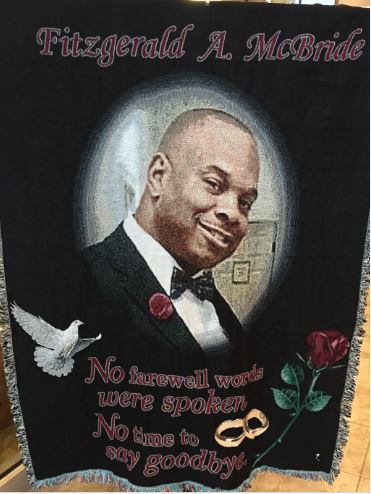Fitzgerald McBride was shot twice early on the morning of November 1st in front of 1330 Atlantic Avenue in Bedford Stuyvesant, according to police. He drove himself four blocks to the Interfaith Medical Center, but he died in his car. And last Friday, Hundreds of people flooded through the doors of the Community Baptist Church of Englewood, New Jersey, to celebrate his life.
The faces of those in mourning were diverse. There were family member, friends, artists and EMT’s. Some came clad in black, while others were draped from head to toe in white. Others still wore T-shirts with McBride’s face ironed on to the front, and “Why you York?” scrawled across the bottom. And they were are all there to say goodbye to very different men. It was apparent that McBride was a man of many parts.

The Reverend Dr. Lester Taylor referred to Mcbride by his full name, Fitzgerald. But few in the audience knew him in that way. To those closest to him he went by York. To others, friends from his modest upbringing in Brooklyn, he was “2 Mean” and the “Brownsville Bully.” To most at the funeral he was described as a good father and a better friend, though to some he was more, a hero and a legend.
McBride was born in Brooklyn in 1968, close in distance but far from the circumstances he found himself in toward the end of his life, living in New Jersey with his wife, Sharon, and his son, Isaiah Threatt, who he had met through New York Children and Family Services, and had legally adopted just weeks ago.
In 2004 he pled guilty to criminal possession of a weapon and was sentenced to up to seven years in prison, according to multiple sources. Before being locked up he made a promise to his girlfriend Sharon: If she would stay with him, when he got out he would marry her and find a way to turn his life around. After he was released he made good on that promise, said family members of Sharon.
“It was a true American hood story,” said Giles Harris, McBride’s brother-in-law, in an interview. “A story about being confused, and getting set on the straight path through a good woman.”
In 2006, after being released from prison, McBride opened a small landscaping and snow removal business with his wife, and began giving job opportunities to men in his old neighborhood. He also worked as a part time DJ at house parties and local clubs, and spent some time with the Bedford Stuyvesant Volunteer Ambulance Corps., where he worked as the driver for Commander James “Rocky” Robinson. He had his shield on him the night that he died, according to Robinson.
“He was out there to save lives in the community, and he was a hero,” said Robinson.
Some of his biggest accolades, however, those which earned him hid designation as a legend, came through his drive to leave a mark—quite literally—on Brooklyn.
An accomplished graffiti artist in Brooklyn, “2 Mean” had been tagging since at least the mid 1980’s. He was remembered fondly in the graffiti community, with images and tidings of support pouring in from artists all over Brooklyn and greater New York. Although even some of his closest friends didn’t know about his work spray-painting walls, the volume of his work led to several run-ins with law enforcement, including over 65 charges of tagging.
“I didn’t even know about the graffiti until after he had died,” Harris said. “He was never the type of guy to brag about himself. He was a rare bread, with a Godfearing invincibility.”
In some of Brooklyn’s toughest neighborhoods, “2 Mean” was a representation of skill and fearlessness who will forever rest in paint. But to friends and family his greatest accomplishments is seen as his ability to set his life back on the right track.
“He was one of the greatest men on earth,” said Jean Alee, his aunt by marriage.


Leave a Reply